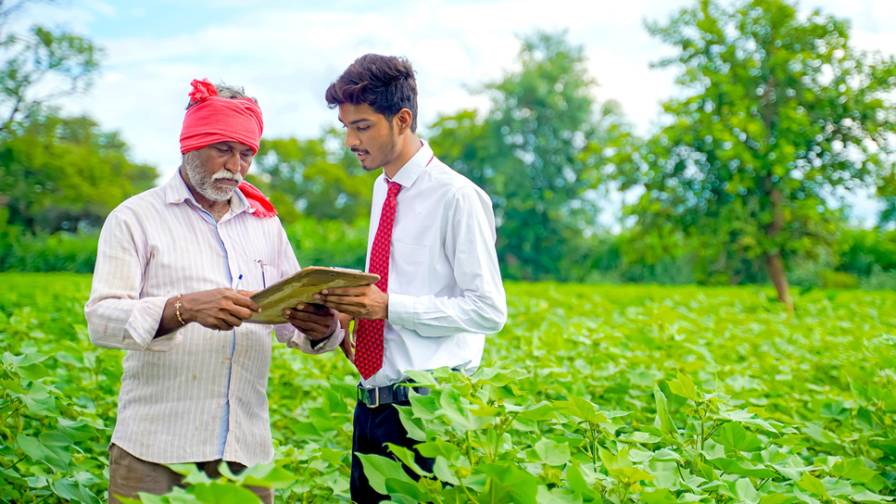Líderes de P&D da Bayer, Corteva, Rovensa Next e outras empresas compartilham avanços na ciência da formulação
Se você está procurando as últimas atualizações sobre novas formulações e P&D, o Agronegócio Global Ao vivo! Webinar sobre novas formulações apresenta uma ótima discussão abrangendo novas formulações que entram no mercado para proteção de cultivos, produtos biológicos e adjuvantes/inertes.
Agronegócio Global pergunta Shaun Selness, Chefe de Ciências Analíticas, Pequenas Moléculas para Ciência de culturas da Bayer; Ashish Batra, Vice-presidente de Pesquisa e Desenvolvimento em Saúde de Cultivos para Corteva; Sara Monteiro, Chefe de P&D Global de Biocontrole e Adjuvantes para Rovensa Próximo; Josué Colmer, Fundador e CEO da TraitSeq; e Lesley A. Schmid, Gerente de Contas Globais, Agro para Evonik perguntas do público do webinar.
ABG: Existe alguma possibilidade e estudo para a mistura de produtos biológicos e ingredientes ativos (IA), onde os IAs não prejudicam o produto biológico, mas são eficazes nas pragas alvo?

Shaun Selness
Shaun Selness (SS): Formulamos e combinamos moléculas sintéticas e biológicas quando necessário, e vários desses produtos já estão disponíveis para os agricultores. Lançado no ano passado, o Tratamento de Sementes Acceleron N-314 oferece proteção contra nematoides e promove o volume radicular no milho, combinando fluopiram e Votivo, este último contendo bactérias vivas que colonizam o sistema radicular e fornecem uma barreira biológica para ajudar na proteção contra nematoides parasitas.
Na soja, o Acceleron Standard inclui bio-melhoradores que protegem contra o estresse de nutrientes e umidade, enquanto os componentes sintéticos do tratamento de sementes defendem contra ameaças como nematoides, insetos e doenças.

Lesley Schmid
Lesley Schmid (LS): A Evonik está iniciando este ano um teste de campo para avaliar a combinação de ingredientes ativos convencionais e biológicos selecionados. Em nossos testes de laboratório, observamos que alguns ativos biológicos fúngicos sobrevivem em nossa formulação sem água, mesmo com fungicidas químicos.
Já existem indícios, a partir de ensaios em estufa e em campo, de que a combinação de ingredientes ativos pode gerar efeitos sinérgicos, sendo possível reduzir a taxa de tratamento do princípio ativo químico. No entanto, existem muitos Ais e testar todos eles não seria prático.
ABG: Qual é o status atual da inteligência artificial (IA) no design de formulações?

Josué Colmer
Josué Colmer (JC): A IA é bastante promissora no design de formulações, mas seu impacto dependerá, em última análise, do acesso a conjuntos de dados amplos, bem estruturados e de alta qualidade. Se as propriedades físico-químicas de ingredientes ativos, adjuvantes e solventes puderem ser codificadas de forma confiável em um formato tabular estruturado, métodos clássicos de aprendizado de máquina, como máquinas de reforço de gradiente, poderão ser muito eficazes na previsão de propriedades-chave de formulações, incluindo absorção e compatibilidade.
Esses modelos poderiam ser aprimorados com a incorporação de insights de modelos de grande linguagem (LLMs) treinados com base na literatura científica relevante. Essa abordagem híbrida combina a previsão numérica precisa a partir de dados estruturados de propriedades físico-químicas com a compreensão contextual obtida a partir de pesquisas publicadas. Juntos, esses sistemas poderiam fornecer recomendações personalizadas para tipos de formulação e combinações de adjuvantes com base no contexto biológico e químico da cultura, planta daninha ou praga alvo.
ABG: Como o TraitSeq treina modelos para fazer recomendações melhores do que os métodos tradicionais?
JC: Na TraitSeq, treinamos modelos de IA em conjuntos de dados de expressão gênica multiambientais diretamente vinculados a resultados fenotípicos. Isso nos permite identificar as assinaturas moleculares subjacentes a características complexas, como eficiência no uso de nitrogênio (NUE), produtividade ou resiliência ao estresse.
Ao contrário da fenotipagem convencional, que se baseia em características visíveis ou mensuráveis, frequentemente avaliadas tardiamente no desenvolvimento, nossos modelos detectam padrões de expressão gênica em estágio inicial que são preditivos de desempenho aprimorado. Por exemplo, um teste de nitrogênio é caro, demorado e influenciado pela variabilidade ambiental. Os modelos do TraitSeq podem identificar marcadores de expressão gênica associados à melhora da EUN a partir de uma única amostra de tecido foliar retirada da planta. Essa abordagem também é capaz de identificar marcadores para capturar processos biológicos subjacentes que são invisíveis à fenotipagem, como a modulação do metabolismo celular ou a melhoria do transporte de açúcares e nutrientes.
Isso permite que as empresas avaliem candidatos com mais eficiência e confiança, selecionando aqueles com maior probabilidade de sucesso antes de se comprometerem com testes caros. Nossos modelos não apenas preveem quais candidatos terão um bom desempenho, como também explicam o porquê – oferecendo uma combinação poderosa de precisão preditiva e insights biológicos.
O TraitSeq oferece uma mudança radical em precisão, velocidade e percepção biológica em comparação às abordagens baseadas apenas em fenótipo.
ABG: Que insights você pode fornecer sobre o desenvolvimento de formulações para combater a deriva e a volatilidade?
LS: A deriva e a volatilidade podem ser afetadas pela viscosidade da formulação e pelo tamanho das partículas das gotículas. Adjuvantes podem ser usados para influenciar ambos os critérios. Adjuvantes também podem auxiliar na adesão e diminuir a taxa de evaporação.

Sara Monteiro
Sara Monteiro (SM): Projetar formulações para combater deriva e volatilidade requer uma abordagem multifacetada que integre química, ciência de formulação e tecnologia de aplicação.
Se o ingrediente ativo tiver alta pressão de vapor, o que significa que é fácil de volatilizar, estratégias de liberação controlada devem ser selecionadas. Por exemplo, a microencapsulação ajudará na redução da volatilização, mas não será de grande ajuda na redução da deriva. A melhor situação que contribuirá para reduzir ambos os problemas são formulações em gel ou emulsões invertidas.
Além disso, devem ser utilizados coformulantes funcionais que visem especificamente a supressão da volatilização, como inibidores, e a redução da deriva, como polímeros ou emulsificantes invertidos para criar gotículas grandes e pesadas. Por fim, a seleção das tecnologias de aplicação adequadas também deve ser considerada. Por exemplo, o uso de bicos de baixa deriva é fortemente recomendado.
ABG: Qual a sua opinião sobre estratégias de encapsulamento para formulação? Isso dificulta os processos de registro?
LS: Atualmente, não oferecemos produtos para encapsulamento. Dada a nossa experiência limitada, e particularmente na Europa, é extremamente importante considerar encapsulamentos livres de microplásticos para fins de registro.
SM: De fato, estratégias de encapsulamento em formulações agroquímicas oferecem benefícios significativos, mas também introduzem complexidades, especialmente no processo de registro regulatório.
O encapsulamento (especialmente o micro e o nanoencapsulamento) reduz significativamente a perda de vapor de ativos voláteis e permite a entrega sustentada de ingredientes ativos, reduzindo a necessidade de aplicações frequentes e minimizando o impacto ambiental. No entanto, o tipo de sistema utilizado, como polímeros sintéticos, pode persistir no meio ambiente. A UE e outras regiões estão se mobilizando para proibir microplásticos, o que impacta diretamente as formulações de suspensão de cápsulas (CS) e tratamento de sementes. Portanto, a seleção de polímeros de base biológica é fundamental para abordar essas preocupações. Além disso, o encapsulamento também traz outro nível de complexidade na caracterização dos produtos, o que pode levar a tempos de aprovação mais longos ou a requisitos adicionais de dados.
O encapsulamento oferece vantagens claras em formulações agrícolas, mas complica o processo de registro. As empresas precisam investir em caracterização robusta, testes de segurança e se manter à frente das tendências regulatórias, especialmente em relação à sustentabilidade ambiental.
ABG: Existe alguma ideia de metodologias de aplicação alternativas para coaplicar micróbios e produtos químicos tradicionais, como uma caixa de plantio?
LS: A capacidade de combinar ingredientes ativos químicos e biológicos depende fortemente da estabilidade física de ambos os produtos e da sensibilidade da viabilidade microbiana. Alguns produtos podem ser aplicados em conjunto sem impacto no desempenho. Se um microrganismo for muito sensível, metodologias alternativas podem ser necessárias, mas serão específicas para o tipo de organismo e o tipo de formulação. A compatibilidade da mistura em tanque deve ser sempre testada caso a caso.
SM: Há um interesse crescente em metodologias alternativas de aplicação — incluindo tratamentos em caixas de plantio — para a coaplicação de produtos microbianos e agroquímicos tradicionais. Essa abordagem está ganhando força devido ao seu potencial de aumentar a eficácia por meio de efeitos sinérgicos, reduzir o impacto ambiental e simplificar a logística para os agricultores.
Em termos de métodos de aplicação, os tratamentos em caixas de plantio são um bom exemplo, onde micróbios e produtos químicos são aplicados diretamente no sulco ou trincheira durante o plantio. Este método garante a proximidade da zona radicular, aumentando a colonização microbiana e a disponibilidade de nutrientes. Outros métodos potenciais são o revestimento de sementes e sistemas de irrigação por gotejamento, que fornecem micróbios e fertilizantes solúveis através de linhas de irrigação.
O encapsulamento de micróbios está sendo usado para protegê-los durante a coaplicação com fertilizantes ou pesticidas.
ABG: Como você reduz a atividade de água em formulações biológicas líquidas?
LS: Por meio de múltiplas ligações de hidrogênio, podemos coordenar até 1-2 % de água com nossos produtos BREAK-THRU BP.
SM: A redução da atividade de água em formulações biológicas líquidas é crucial para aumentar a vida útil e a estabilidade microbiana. Algumas estratégias incluem o uso de umectantes que reduzem a atividade de água sem remover completamente o conteúdo de água. Exemplos comuns incluem glicerol ou açúcares (por exemplo, trealose, sacarose), frequentemente usados em formulações microbianas para estabilizar células durante o armazenamento. A adição de sais como cloreto de sódio ou cloreto de potássio pode reduzir a atividade de água, criando pressão osmótica. Outras tecnologias, como o encapsulamento em carreadores ou emulsões à base de óleo, também podem reduzir a atividade de água efetiva.
No entanto, uma das melhores estratégias é usar sistemas à base de óleo ou emulsão, substituindo a água por veículos à base de óleo (por exemplo, óleo mineral, óleo vegetal) ou usando emulsões de água em óleo, o que pode reduzir significativamente a atividade da água, mantendo a fluidez.
ABG: Por favor, confirme como preservar esporos microbianos intactos em formulações líquidas/em pó por um prazo de validade de dois anos?
LS: Observamos maior sucesso ao limitar a atividade aquosa da formulação.
SM: Para preservar esporos microbianos em formulações líquidas ou em pó por uma vida útil de até dois anos, diversas estratégias devem ser cuidadosamente implementadas, dependendo do tipo de formulação e das espécies microbianas envolvidas.
Formulações em pó são geralmente mais estáveis e preferidas para armazenamento de longo prazo. Nesse caso, as principais estratégias estão relacionadas ao controle da atividade de água, que deve ser <0,2 para inibir a degradação microbiana, e à atividade enzimática, utilizando dessecantes ou embalagens com barreira à umidade para manter a água do mar baixa. O uso de protetores e carreadores inertes, como caulim ou linhito, é muito importante para garantir a distribuição e a estabilidade.
Formulações líquidas são mais desafiadoras devido à maior atividade de água, mas podem ser estabilizadas com as técnicas corretas, como o uso de fluidos transportadores com baixa atividade de água, por exemplo, substituir a água por solventes com baixa atividade de água, como glicerol, propilenoglicol ou polietilenoglicol, usar osmoprotetores e conservantes que não danificam os esporos, mas previnem a contaminação e/ou usar tecnologias como encapsulamento em emulsões à base de óleo ou polímeros biodegradáveis para isolá-los da água e do oxigênio.






